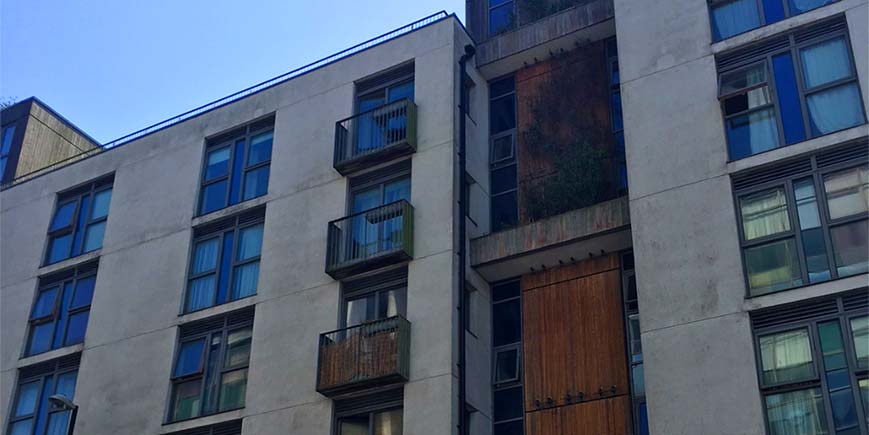This information should not be interpreted as financial, tax or legal advice. Mortgage and loan rates are subject to change.

Categories: hmo | guides | hmo mortgage guides
Large houses in multiple occupation (HMOs) can be both complex and rewarding. They usually give more income than regular rentals, because each bedroom generates rent, which makes them appealing to investors.
Because there are multiple tenants, rental voids (periods where there is no tenant paying rent) have less financial impact, as there will still be rental income from all the other tenants.
However, large HMOs also require more management and maintenance and are subject to more health and safety regulations.
We guide you through some of the points of difference about this type of property and what the implications are when getting a large HMO mortgage.
The details below summarise and signpost information relating to this subject, but you must take professional legal advice to ensure you adhere to health and safety regulations, as the lives of tenants are at risk. We do not accept any liability in respect of any loss, cost or liability (whether or not avoidable in each case) that may be suffered or incurred as a result of using this document or any part of this document.
Legal classification of HMO properties
Section 254 of the Housing Act 2004 describes three types of HMO property:
- The standard test - Tenants living in an house who are from more than one household and who share basic amenities (a bathroom, toilet or cooking facilities)
- The self-contained flat test - Tenants living in a flat who are from more than one household and who share basic amenities within the flat (a bathroom, toilet or cooking facilities)
- The converted building test – An HMO where a building has been converted into flats, but where not all of the flats are fully self-contained and amenities may not be shared.
Section 255 of the Housing Act 2004 describes a notice that a local housing authority can impose on a building, an “HMO declaration”, when it feels the building should be classed as an HMO property, even if it is not used solely as living accommodation.
Section 256 of the Housing Act 2004 describes the removal of a Section 255 “HMO declaration” by a local authority, at a point where they are satisfied a building should no longer be classified as an HMO.
Section 257 of the Housing Act 2004 describes a HMO property that has been converted into a self-contained block of flats, where various other factors apply.
Mandatory licensing of large HMO properties
Since 2006, large HMO properties with five or more people from two or more households must be licensed by the local authority appropriate to the location the property is in.
Whilst the legislation originally applied to buildings of three storeys or more, because more and more one and two storey buildings started to be used as HMO’s, this rule was changed and now buildings with any number of storey’s can be classed as HMO’s.
An HMO licence is valid for 5 years. To qualify for one you or an agent managing it for you must be “fit and proper” to do so, which means that person has no criminal record and has never been in breach of landlord laws or codes of practice. This amongst other legal requirements relating to occupancy, health and safety.
The local authority is required to keep a register of these licences.
This licensing process requires landlords to meet specific standards related to safety, sanitation, and property management. Licensing requirements can vary from one local authority to another, so it's essential to check with the local council for your HMO property.
Health and safety in large HMO properties
All rental properties must offer a safe living environment for tenants, but with HMO properties the impact of many households living in one premises requires some additional health and safety measures, some of which are specific to large HMOs.
Fire safety in a large HMO
To adequately mitigate the risk of fire in a HMO the landlord or person in charge of the HMO property are legally required to put in place adequate fire safety measures.
The government provides a “Fire Safety Risk Assessment” for sleeping accommodation, which is relevant for communal areas of HMO property.
They also provide a supplementary guide which covers “Means of Escape Routes for Disabled People”
HMOs with one or two floors must have a fire detection system that meets British Standard BS5838 Part 6 LD2 Type D1 and must include:
- Smoke detectors in the entrance, hallway, living areas, landings and basements or cellars which are mains powered and interlinked.
- A heat detector in the kitchen which is fixed temperature and interlinked.
- A fire blanket in the kitchen that complies to British Standard BS EN:1869.
- Smoke alarms which are interlinked in the lounge.
- A fire escape route which leads to a place of safety.
- Fire doors on all doorways that open to the main fire escape route (they must be sound, close-fitting traditional solid construction – not hollow).
- Internal windows along the fire escape route must be fire rated Georgian wired (an industry definition for a specific type of safety glass with wire running through it) or covered by 12.5mm plaster board on both sides.
- A keyless exit.
- A protected loft hatch.
HMOs with three floors or more must have a fire detection system that meets British Standard BS5838 Part 6 LD2 Type D1 and must include:
- Smoke detectors in the entrance, hallway, living areas, landings and basements or cellars which are mains powered and interlinked.
- A heat detector in the kitchen which is fixed temperature and interlinked.
- A fire blanket in the kitchen that complies to British Standard BS EN:1869.
- Smoke alarms which are interlinked in the lounge and all risk rooms including all bedrooms.
- A fire escape route which can provide a minimum of 30 minutes fire resistance (meaning walls and ceilings must be able to resist fire) and leads to a place of safety.
- Fire doors on all doorways that open to the main fire escape route must adhere to the minimum 30 minutes of fire resistance at 800 degrees Celsius (they must be sound, close-fitting traditional solid construction – not hollow, with no rising butt hinges).
- Self-closers, smoke seals and intumescent strips (all of an approved standard) on all fire doors leading to the fire escape route.
- Internal windows along the fire escape route must be fire rated Georgian wired (an industry definition for a specific type of safety glass with wire running through it) or covered by 12.5mm plaster board on both sides.
- A keyless exit.
- A protected loft hatch.
- Emergency lighting may be necessary along the fire escape route.
From 23rd January 2023, the Fire Safety (England) Regulations 2022 apply, which came about as a result of the Grenfell Tower Inquiry. This results in fire safety changes not just for high-rise buildings, but also for HMOs.
The *responsible person for all HMOs must:
1. Provide tenants with fire safety instructions that cover:
a) How to report a fire
b) What to do if there is a fire
c) How to evacuate the building
2. Provide tenants with information that makes clear how important fire doors relating to fire safety.
Definition of a *“responsible person”
The “responsible person”, in relation to fire safety, is the person responsible for the safety of the occupants of a regulated property. This will usually be the owner of the property or the person in control of the property.
If you are unclear on whether or not you are the responsible person, you should seek legal advice (and not the fire and rescue service, for example).
Electrical safety in a large HMO
Under Section 67(1) of the Housing Act 2004 the licence holder for the HMO must keep all electrical appliances that have been supplied by them in a safe condition. Declarations showing the safety of electrical appliances need to be available to give to the local authority if they are requested.
The law around electrical safety for the entire rental sector is described in “The Electrical Safety Standards in the Private Rented Sector (England) Regulations 2020”. It includes ensuring:
- Electrical safety standards are met when a property is occupied;
- Electrical appliances are inspected and tested regularly (at least every 5 years and possibly more often if a previous report requires it) by a qualified person;
- Electrical inspections and testing are completed before a new tenancy starts;
- The professional inspecting and testing the appliances gives a report showing the results and when the next inspection and testing must be done;
- A copy of the electrical report is given to the existing tenants within 28 days of it being done;
- A copy of the electrical report is given to the local housing authority within 7 days of a written request;
- A copy of the electrical report is kept until the next one is done, so it can be given to the qualified person doing the next inspection and testing;
- A copy of the electrical report is given to any new tenant before they live in the property
- A copy of the electrical report is given to any prospective tenants within 28 days of a request in writing from them.
Where electrical safety standards are identified as not being met, the landlord must:
- Get further investigative work done and get the issue fixed by as qualified person within 28 days of it being reported; or, within any shorter timeframe stipulated in the report;
- Get written confirmation from the qualified person that the issue is fixed or if more work is needed to fix it;
- Give a copy of the new report, with a copy of the original report highlighting the problem, to the tenants and to the local authority within 28 days of the follow up investigation or fix being done.
Where the issue still is not fixed, steps 1-3 must be repeated.
Planning rules relating to large HMOs
Given that HMOs can have an impact on their local area, especially where multiple HMOs are grouped together in the same area (as a result of the higher density of tenants per property), local councils may impose planning controls on them.
General Permitted Development Orders and Article 4 Directions in relation to HMOs
To give it its full title, “The Town and Country Planning (General Permitted Development) (England) Order 2015” often allows you to convert a house into a small HMO (three to six tenants) without needing planning permission.
However, if a local council imposes an Article 4 Direction in the location you are buying, you should check if it will affect your HMO.
In planning law, converting a domestic residential property into an HMO is referred to as converting a “Class C3 Dwelling house” into a “Class C4 Small House in Multiple Occupation”.
An Article 4 Direction is a planning control tool in the United Kingdom that allows local authorities to restrict the scope of permitted development rights in a particular area.
The goal is often to manage the character and appearance of an area, and to prevent undesirable changes that may negatively impact the local environment. An Article 4 Direction can be used to require planning permission for changes that would normally be allowed without it.
The impact of an Article 4 Direction on a large House in Multiple Occupation (HMO) would depend on the specific details and restrictions outlined in it.
If an Article 4 Direction is in place in the area where the large HMO is located, it could mean that certain changes or alterations to the property that would typically be permitted without planning permission may now require it.
To find out if the location of your HMO is affected by this legislation, contact the local planning authority for the area.
Sui Generis HMO properties
Sui Generis is Latin for ‘of its own kind’ and describes properties that fall outside standard planning use classes and so falls within a class of its own. Large HMOs are one of these types of property (there are many others, which can be found on the Planning Portal).
A Sui Generis HMO is one occupied by seven or more unrelated tenants. Where there are this number of tenants, a large HMO is automatically classified within planning regulations as a Sui Generis HMO.
So, if you wanted to change your HMO from 6 or fewer occupants to seven occupants or more, it will change from a C4 use class to a Sui Generis use class.
Where an HMO falls under a Sui Generis use class, it effectively means it is more similar to a commercial property than it is to a residential property and as such health, safety, transport and parking and structural requirements differ.
When it comes to getting a mortgage, a lender will want to see that a large HMO with seven occupants or more has Sui Generis planning approval.
Large HMO mortgage lenders and rates
Understanding the different approach high street and specialist lenders take to their HMO mortgage offerings will help you understand the variation in rates that you will come across.
How do lenders define “large” HMO properties?
In general in the eyes of mortgage lenders, “large” HMOs are properties that are rented out to a minimum or five or six people, or more, who are not part of one household.
As with any HMO, the tenants share common areas like kitchens, bathrooms, and living rooms.
For instance, some lenders (typically high street lenders who prefer to lend on more standard properties) limit a small HMO to four tenants, others will allow five tenants on a small HMO mortgage. It depends on their criteria.
Where small HMO’s are accepted, the lender will typically be treating the property as though it is a standard residential home which could, in the event of a repossession, be sold on to any homebuyer. As such, they may ask for all tenants to be party to one Assured Shorthold Tenancy Agreement, so that all tenants are tied to the same tenancy agreement dates in case they had to be asked to leave the property so it could be sold.
By contrast, large HMO’s typically have to be mortgaged with a specialist lender, as they will have physical features that mean they cannot be sold on as a residential property at all, or without works being done.
This means the lenders who accept large HMO’s carries more risk.
Property types can involve anything from large houses, multi-storey townhouses to converted commercial properties.
Large HMO mortgage rates
As described above in “How do lenders define “large” HMO properties?”, there are two broad groups of HMO lenders, those that lend on small HMOs and those that lend on large HMOs. Large HMO’s carry more risk, which means the mortgage interest rates applicable to them tend to be higher.
When you review an HMO mortgage calculator it is impossible to distinguish the small HMO rates from the large HMO rates. You need to know each lenders criteria. This is why talking to a specialist HMO mortgage broker is helpful.
It is not just the size of your property that will affect the HMO mortgage rate you can secure, you might also be applying through a limited company, which will impact the rates available to you, you might be applying as an expat, and there are a wide range of other factors that make you a good fit, or not, with a lender (e.g. loan to value, location of property, history of property, rental coverage and more).
Lenders do not decide on cases because they see them as ‘good’ or ‘bad’, they look at cases they are designed to handle as a result of their business model.
Get help with a large HMO mortgage
If you need help understanding which product best fits your needs and circumstances, when it comes to a large HMO mortgage, you can speak to our specialist broker team.
The phone number at the top of this page dials straight through to our advising team, there are no annoying phone menus. Or, simply request a call-back here.


